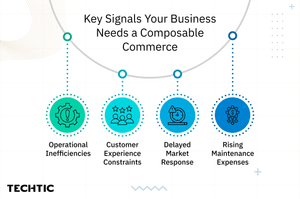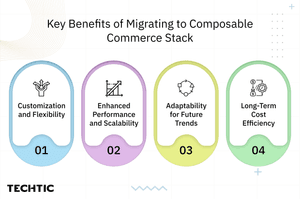When It’s Time to Migrate to a Composable Commerce Stack?
Sector: Digital Commerce
Author: Nisarg Mehta
Date Published: 09/12/2024

Contents
There is a growing trend of composable commerce emerging as an adaptable and highly extensible solution to traditional monolithic eCommerce platforms. With composable commerce, companies can build their commerce stack from individual, optimized software components, which are much better suited to address detailed business requirements.
But, it must be noted that this approach is effective only if migration is done at the right time. Timing on when to shift is essential in order to harness the full potential of composable commerce without causing too much disruption where it is not necessary.
4 Signs That Indicate It’s Time to Migrate
The following are the indicators that you should shift to a more flexible eCommerce architecture:

1. Increased Operational Complexity
When the size of your business is scaled up, handling multiple integrations, plugins, and third-party services become challenging. This operational complexity is usually reflected in inefficiencies and increased costs. Composable commerce makes it easier to run your business since you only select the components you need to make your work easy.
2. Need for Better Customer Service
Ensuring that customers receive a tailored and integrated experience is crucial in today’s consumer environment. If the rigidity of the currently used platform does not allow it, transitioning to a composable commerce stack is possible. This is because composable commerce is flexible, making it easier for a business to transform customer experiences and adapt at a faster pace.
3. Need for Faster Time-to-Market
A fast-growing market means it is expensive to delay product release or updates to available products. If your platform is gradually slowing down these processes, then this is an obvious sign that a change is required. Composable commerce can be launched and evolved quickly, enabling you to outcompete rivals in the quest for market share.
4. High Maintenance Costs
With new technology being developed, it becomes more and more expensive to maintain a legacy system. If you are experiencing increased costs and minimal tangible outcomes, it is high time to shift to the composable commerce approach. It is almost always less expensive in the long run and because of its modularity, it requires less maintenance.
Advantages of Migrating to a Composable Commerce Stack
Composable commerce brings numerous benefits. Here are the key ones:

Enhanced Flexibility and Customization
Probably one of the biggest strengths of composable commerce is the fact that you can build your eCommerce stack in a way that would better suit your business. This means you can select from an ocean of solutions and implement only the ones that will suit your needs. Such a level of flexibility is seldom possible with the monolithic eCommerce architectures.
Improved Performance and Scalability
With composable commerce, you are able to improve areas that require change the most without having to affect the entire structure. Therefore your business gets a capacity to accommodate the incoming traffic and execute more transactions.
Future-Proofing the Business
The area of eCommerce is still very dynamic, with various technologies and trends constantly appearing. You can be sure that composable commerce prepares your business perfectly for changes like these. By incorporating them as soon as these are available in the market, you make your business sustainable and fit for the future market.
Cost Efficiency in the Long Run
However, the setup cost for achieving composable commerce is higher in the first place, Nonetheless, the payoffs are promising. The factor of integration that composable commerce introduces means that there is often little need for constant updates and maintenance, which makes the endeavor typically more cost-effective in the long run.
Considerations Before Migrating
Before and while migrating, there are certain things that you should look into:
Assessing Business Needs
As you prepare to transition to the composable commerce model, it is imperative to take stock of your company’s requirements. Find out if flexibility and customization as provided by composable commerce fit your business needs. This assessment is key in enabling you to determine whether migrating is the right decision at this point.
Evaluating Current Infrastructure
It is important to grasp the imitations of the current eCommerce platform you are using. Determine if you already have the necessary infrastructure for composable commerce or if major improvements must be conducted. This step is taken to make sure that the migration process as well as incorporation of the new system with your processes will be smooth.
Cost and Resource Allocation
The transition to the composable commerce stack is very capital-intensive in terms of both money and time. When migrating, one needs to have a financial plan in order to be able to meet the costs of migrating as well as hire the correct personnel to handle the migration process. Sustainable planning in this area would be instrumental in preventing such incidences of unanticipated costs and time overruns.
Finding the Right Partners
The choice of right vendors and eCommerce technology partners is strategic for the given process of migration. It is also advisable to work with partners who have successfully implemented composable commerce. This is a great advantage because they will be able to assist you in navigating the various challenges that come with the process of migration.
Wrapping Up
The move to have a composable commerce stack brings some advantages that may include; improved agility, improved cost, and reduced venture risk. However, timing is key. If one understands when such a move is necessary and gives proper consideration to the problems, he can succeed in performing migration in the most efficient manner.
It is strongly recommended to consider your current position and think about your further migration strategies, as this approach will create the best preconditions for your business’s further development.



